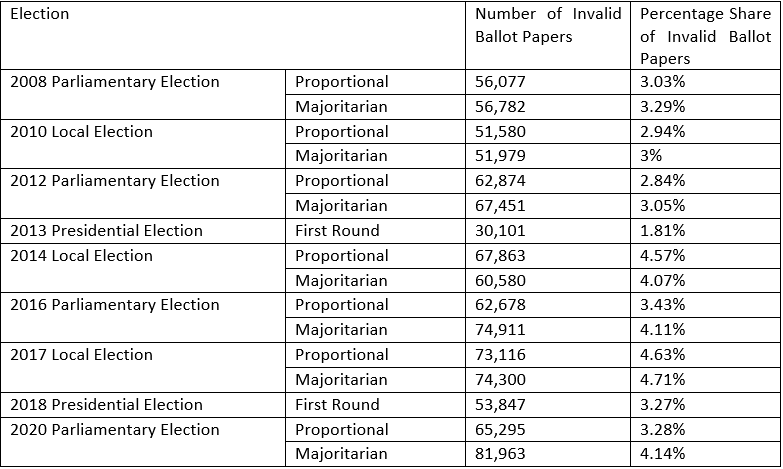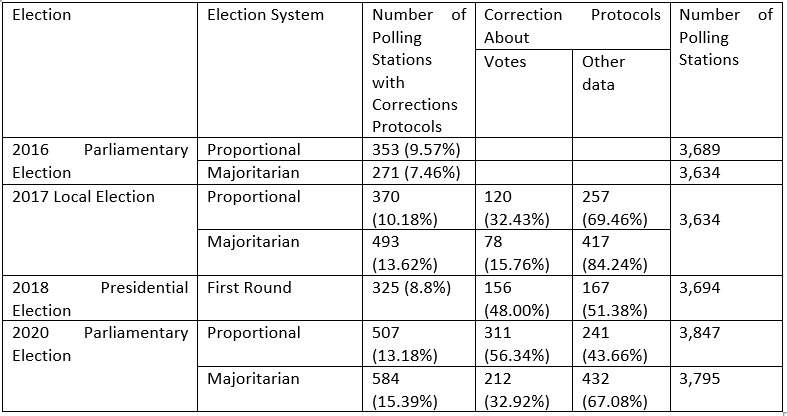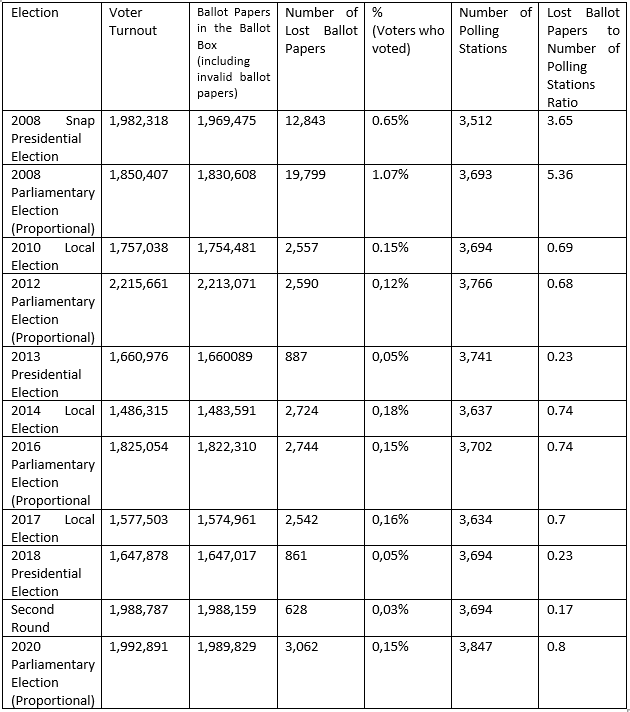Resume: Some information in the video is true, although all claims are manipulations of facts and aim to undermine people’s support for protest and mislead the public.
Analysis:
On 16 November 2020, the Georgian Dream released a video on its official Facebook account. As clarified by the party, the aim of the video was to counter five items of disinformation circulating in regard to the 31 October election. FactCheck took interest in the accuracy of facts in the video. Given below are each and every fact in the video together with the analysis of relevant statistical information.
Video Fact No. 1: “It is disinformation that the CEC was very late in announcing the preliminary results. In fact, there was delay from the CEC and the initial results were announced as usual in an average announcement time.”
The CEC Chairperson, Tamar Zhvania, announced the preliminary results of the 31 October 2020 parliamentary election at 3:30 AM on 1 November 2020. Since 2012, the 2020 parliamentary election results have been announced with the biggest delay. According to Table 1, the average time for announcing preliminary results is six hours after the polls close. The preliminary results of the 31 October elections were announced after 7 hours and 30 minutes which is an hour and a half more as compared to the average time for announcing preliminary results. Therefore, the information in the video in regard to the announcement of the preliminary results of the 31 October 2020 parliamentary elections is MOSTLY FALSE.
Table 1: Elections in 2012-2020 and Preliminary Results Announcement Timing (First Round Data Only)

Source: Central Election Commission
This table clearly illustrates that since 2012, the CEC has not needed so much time to publish the initial results. Moreover, parliamentary election statistics are a good fit for comparison since different elections are held in different manners and vote tabulation may take different amounts of time. Therefore, if we compare the time the CEC took to announce the preliminary results of the 2016 parliamentary election and the 2020 parliamentary election, we find that the CEC had a two-hour delay in 2020 to publish the preliminary results as compared to 2016.
Video Fact No. 2: “It is disinformation that the number of invalid ballot papers is high. In fact, since 2008, invalid ballot papers are within a 3-4% margin.”
According to the results of the 31 October 2020 parliamentary election, a total of 65,295 ballots were annulled in the proportional election whilst the number of invalidated ballots in the majoritarian election was 81,963. The number of invalid ballot papers in the proportional part of the election indeed does not differ significantly from the invalid ballot papers in previous elections.
The number of invalid ballot papers (81,963) in the majoritarian part of the 2020 election is 7,000 more as compared to same figure in 2016 and 14,000 more as compared to same figure in 2012 (see Table 2). Of note is that the Georgian Dream video contains no information about the highest number of invalid ballot papers in the majoritarian part of the election. Therefore, this claim is MOSTLY FALSE since the video only contains data which corroborates the Georgian Dream’s statement.
Table 2: Number of Invalid Ballot Papers in Elections Held from 2008 to 2020 (First Round Data)

Source: Central Election Commission
Here, we may reiterate the fact that it would be appropriate to compare data of the same type of elections – in this case that would be parliamentary elections. The table shows that the number of invalid ballot papers in 2020 both in real numbers and in the percentage share substantially exceed the same figures of the previously held elections. This includes the 2012 parliamentary election, which was followed by the change of power, and the 2008 parliamentary election which was protested and boycotted by the then opposition.
Video Fact No. 3: “It is disinformation that there is a large number of correction protocols in 2020. In fact, there were 1,171 correction protocols in 2020 and the 2017 local election had almost the same number of correction protocols. In 2016, the number of correction protocols was lower but there were 23 registered subjects at that time whilst this year there were 50. In addition, the Ajara Supreme Council election was also held.”
According to the CEC’s data, there were 1,228 correction protocols in the first round of the 31 October 2020 parliamentary election which is 356 more as compared to the number of correction protocols in the 2017 local election (see Table 3). Therefore, the information in the video that the number of correction protocols in the 2017 and 2020 elections are almost equal is a LIE.
In the proportional part of the 31 October 2020 parliamentary election, 552 correction protocols were made at 507 polling stations. In the majoritarian part of the election, 664 correction protocols were made at 584 polling stations. The Table 3 clearly illustrates that both the number of correction protocols and the number of polling stations where the correction protocols were prepared significantly exceed the similar figures of the elections from the previous years.
Table 3: Number of Correction Protocols and Polling Stations with Correction Protocols in Elections Held in 2016-2020 (First Round Data)

Source: Central Election Commission
The authors of the video seek to explain the increased number of correction protocols by the holding of the Ajara Supreme Council elections in parallel and the participation of a large number of electoral subjects (50). Of note is that such a claim is outright wrong and manipulative. Holding the voting process orderly and without irregularities is one of the CEC’s most important responsibilities. In the pre-election period, the CEC has to ensure the improvement of the qualification of election administration personnel and provide training to prepare them to properly handle the voting process irrespective of the number of electoral subjects or other factors. Therefore, the argument in the video underpins the public’s suspicions in regard to the parliamentary elections instead of dissipating those suspicions and raises more questions about the CEC’s competence. In addition, a comparison between the different parliamentary elections shows that the number of correction protocols in 2020 is significantly higher as compared to those in 2016.
Of additional note is that similar to 2020, the parliamentary election and the Ajara Supreme Council election were also held simultaneously in 2016. However, the claim in the video is formulated in such way that there was no Ajara Supreme Council election in 2016 and the increased number of correction protocols in 2020 can be explained precisely by the holding of the Supreme Council election simultaneously with the parliamentary election. Therefore, we may say that the claim in the video in regard to correction protocols is a MANIPULATION OF FACTS and aims to spread wrong information among the public.
Video Fact No. 4: “It is disinformation that there are many mismatched protocols. In fact, as of today, there are nearly 966 mismatched protocols. In the 2016 election, the number of mismatched protocols was nearly 900. This is typical technical fault which usually accompanies the elections.”
According to the CEC’s data, mismatched protocols were identified at 943 polling stations in the proportional part of the 2020 election as of 14 November 2020. The sums of invalid ballot papers and real votes exceed the total number of voters who turned out to vote at 19 polling stations. The sums of invalid ballot papers and real votes at 857 polling stations are less than the total amount of voters who voted.
Table 4: Ballot Misbalance Figures in Elections Held in 2008-2020 [1]

Source: Central Election Commission
According to the final results of the election, the number of lost ballot papers in the proportional part amounted to 3,062 (0.15%). Of note is that since the 2008 parliamentary election, the lost ballot paper figure is the highest in the proportional part of the 2020 election.
Both the Georgian Dream video and the CEC’s statement say that the ratio of mismatched protocols identified in the proportional part of the 2020 elections is the same as in the 2016 parliamentary election, is slightly less as compared to the 2014 and 2017 local elections and sharply differs from the figures in the 2008 presidential and parliamentary elections.
First and foremost, a comparison of identified irregularities with those in previous years and making an impression that “nothing exceptional happened” in the 2020 election is in essence wrong and aims to undermine the legitimate protest sentiment among the public. In regard to the argument in the video, it would have been right had there a been a directly proportional relationship between the mismatch figure and voter turnout. However, as shown in Table 4, there is no such correlation. For instance, voter turnout in the 2012 election was nearly 220,000 more as compared to 2020 whilst the number of lost ballot papers was 500 less. In the run-off of the 2018 presidential election, voter turnout is similar to the first round voter turnout in the 2020 parliamentary election, although the number of lost ballot papers is five times higher as compared to 2018. Therefore, as mentioned previously, the argument in the video and the CEC’s statement lacks ground. In addition, the lost ballot papers to the total number of polling stations ratio shows that there were eight ballot papers lost per ten polling stations on average in the 2020 parliamentary election. This has been the highest figure since the 2008 election.
Of importance is to analyse the missing ballot papers in the proportional part of the 2020 election in the wider context of election assessment. The observer organisations identified multiple gross violations during the 31 October election, including the so-called “carousels.” On 1 November 2020, the International Society for Free Elections and Democracy (ISFED) published results of the 31 October election parallel vote tabulation. According to the report: “In the vote tabulation process, there was a tendency of mismatches in the summary protocols when the number of ballot papers cast exceeded the number of signatures in voters lists which represents a violation. Additionally, at certain polling stations the mismatch was significantly higher than individual cases. Such violations were reported at 8% of the polling stations and a tendency of this scale has not been documented in the past years and, hence, this requires particular attention. Although such a tendency could have had a certain influence on the results of electoral subjects, the PVT analysis shows that its maximum impact on election results would be less than 4.1%. This tendency endangers trust towards the electoral process and requires an immediate reaction from the electoral administration.” Given this assessment and considering the fact that the highest figure of lost ballot papers was registered in the 2020 parliamentary election further deepens public suspicion in regard to the reliability of the election.
Eventually, we may say that the video’s claim in regard to mismatches is a MANIPULATION OF FACTS.
Video Fact No. 5: “It is disinformation that an unprecedentedly large number of complaints were filed. In fact, the number of complaints filed by NGOs in 2020 is 71 less as compared to 2016. Instead, political parties filed 738 more complaints.”
According to the CEC’s data, a total of 2,092 complaints were filed at the District Election Commission by local observer organisations and electoral subjects in regard to the 31 October 2020 parliamentary election on and after voting day. Of this amount, 633 complaints were filed by observer organisations and 1,459 by electoral subjects. In accordance with the 2016 election summary report, there were 1,168 complaints/statements filed at District Election Commissions in regard to the voting day (first round). Of this amount, electoral subject filed 507 complaints and observer organisations filed 635. The video highlights that as compared to 2016, observer organizations filed 71 less complaints in 2020. However, based on the CEC’s official data, complaints filed by observer organisations in 2016 and 2020 are almost equal. Of additional note is that in these circumstances the number of complaints is not that important. The opposition and NGO sector gave negative assessment to the 31 October election. As stated by the ISFED, 8% of polling station requires recounts. In addition, Georgia’s Young Lawyers’ Association (GYLA) and Transparency International Georgia demand the invalidation of 117 and 42 polling stations, respectively. Therefore, the content of the complaints and the identified irregularities are more important than the number of complaints. Therefore, the information in the video is a MANIPULATION OF FACTS. The video makes emphasis on the increased number of complaints from electoral subjects whilst it disregards the content of the complaints and the gravity of the irregularities identified by the electoral subjects and observer organisations during the voting process.
Table 5: Number of Complaints/Statements Filed at the District Election Commission in Regard to Voting Days in Elections Held in 2016-2020

Source: Central Election Commission
As a conclusion, we may say that the video released by the Georgian Dream is a MANIPULATION OF FACTS. Some pieces of information in the video are true, however, the video mostly includes such claims which aim to undermine people’s support for protest and mislead the public.







